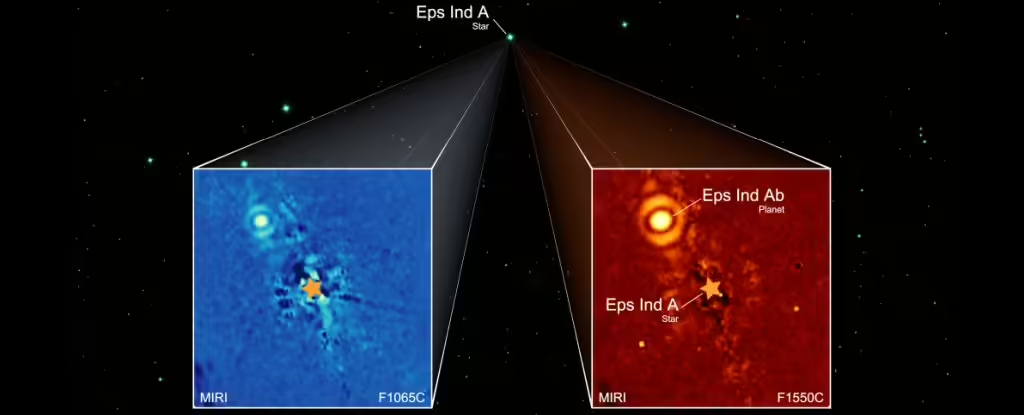JWST discovers Super Jupiter
- July 24, 2024
- 0
With JWST, astronomers have discovered a new exoplanet, a gas giant they named Eps Ind Ab. Even more exciting, the exoplanet has been depicted as a separate and
With JWST, astronomers have discovered a new exoplanet, a gas giant they named Eps Ind Ab. Even more exciting, the exoplanet has been depicted as a separate and

With JWST, astronomers have discovered a new exoplanet, a gas giant they named Eps Ind Ab. Even more exciting, the exoplanet has been depicted as a separate and distinct entity, independent of direct observations of its star. It is also the first exoplanet to be photographed by JWST without being imaged by ground-based telescopes.
The newly discovered world is much colder than the gas giants JWST has studied to date; the super-Jupiter orbits its star at a distance comparable to Neptune from the Sun. This makes the discovery a rare treasure among exoplanets and could mark the start of a new chapter in exoplanet science.
“We were thrilled when we realized we had imaged this new planet,” says astronomer Elizabeth Matthews of the Max Planck Institute for Astronomy in Germany.
“We were surprised to see that the bright spot in our MIRI images did not match the planet’s expected location. Previous studies had correctly identified a planet in this system, but this super-Jupiter underestimated the gas giant’s mass and the distance between their orbits.”
To date, astronomers around the world have discovered and confirmed the existence of approximately 5,700 exoplanets, or planets outside the solar system, but their detection is generally indirect.
This means we can’t actually see exoplanets. We see their effect on the parent star. An exoplanet passing between us and the star will slightly dim the star’s light, while the gravitational pull of the exoplanet will pull on the star, making it appear to wobble slightly. The reason we rarely see exoplanets is because they are so small, so far away, and the light they can reflect or emit is so dim.
Indirect detection methods also favor larger exoplanets and exoplanets that are very close to their parent stars, because the exoplanet is more likely to pass in front of the star and more frequently, meaning the chance of observing it is much, much higher.
But exoplanets with greater orbital distances are more likely to be detected directly, because the greater distance means that their light is less likely to be drowned out by the star’s light. This is still a tough thing to do (only about 25 exoplanets have been directly imaged to date), but it’s a way to learn more about the farthest reaches of otherwise difficult-to-study alien systems.
Eps Ind Ab’s parent star, Epsilon Indi A, is an orange dwarf in a triple star system just 12 light-years from Earth. During long observations, astronomers noticed that Epsilon Indi A was behaving a little strangely. It appeared to be moving as if it were being pulled by gravity, but it was not being pulled by one of the other two stars in its system, but by a giant Earth orbiting the star.
The properties of this previous exoplanet have been inferred, but without additional data its identity remains unknown.
This is a JWST prompt. The infrared telescope can detect dim light like no other space telescope before it, and it includes a coronagraph that blocks light from the star itself, so Matthews and his colleagues took the time to look at the space around Epsilon Indi A.
And they found something in the star’s orbital field, a bright dot. But surprisingly, it wasn’t where they thought.
Based on their observations and archival data, the researchers were able to determine that the dot in question was not another object located more distant, but in fact an exoplanet. It appears to be a very cold gas giant orbiting Epsilon India A at a distance of about 28 AU, with a period of about 200 years. Neptune is located about 30 astronomical units from the Sun.
Previous estimates suggested a world about three times the size of Jupiter at 8.8 AU away. This huge difference between what we expected to find and what we found shows how valuable direct imaging can be for studying alien worlds.
We’re not done with Eps Ind Ab yet. Researchers hope to make further observations that will help clarify its orbit as well as understand the composition of its atmosphere.
“In the long term, we hope to observe other nearby planetary systems to find cold gas giants that may have escaped detection,” Matthews says.
“Such research will lay the foundation for a better understanding of how gas planets form and evolve.” The study was published on: Nature.
Source: Port Altele
As an experienced journalist and author, Mary has been reporting on the latest news and trends for over 5 years. With a passion for uncovering the stories behind the headlines, Mary has earned a reputation as a trusted voice in the world of journalism. Her writing style is insightful, engaging and thought-provoking, as she takes a deep dive into the most pressing issues of our time.